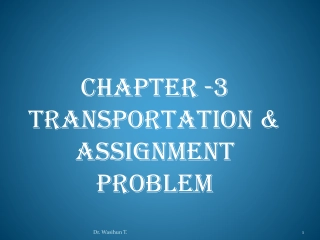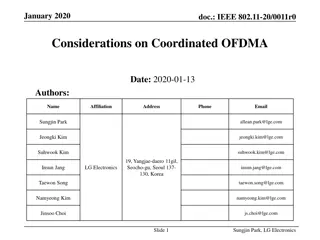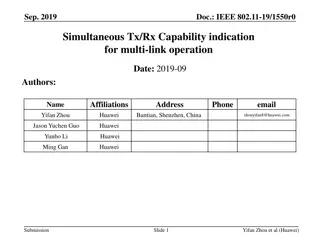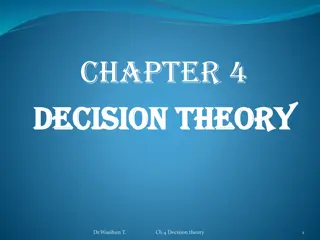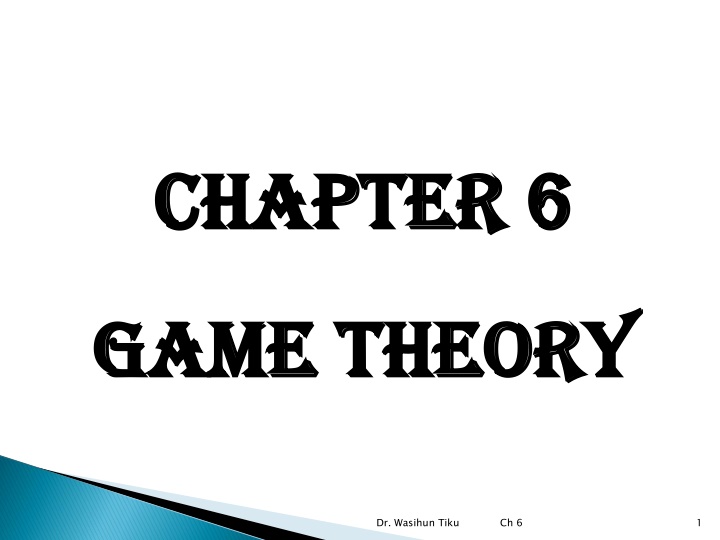
Game Theory: A Mathematical Approach to Competitive Situations
Delve into the world of game theory, a mathematical theory that analyzes competitive situations like games, military conflicts, and business competition. Explore the basics of two-person, zero-sum games and learn about strategies, payoff tables, and rational decision-making processes. Discover how players aim to maximize their outcomes in varying scenarios through strategic planning.
Download Presentation

Please find below an Image/Link to download the presentation.
The content on the website is provided AS IS for your information and personal use only. It may not be sold, licensed, or shared on other websites without obtaining consent from the author. If you encounter any issues during the download, it is possible that the publisher has removed the file from their server.
You are allowed to download the files provided on this website for personal or commercial use, subject to the condition that they are used lawfully. All files are the property of their respective owners.
The content on the website is provided AS IS for your information and personal use only. It may not be sold, licensed, or shared on other websites without obtaining consent from the author.
E N D
Presentation Transcript
Chapter 6 Chapter 6 Game Theory Game Theory Dr. Wasihun Tiku Ch 6 1
Life is full of conflict and competition. Numerical examples involving in conflict include games, military, political, advertising and marketing by competing business firms and so forth. A basic feature in many of these situations is that the final outcome depends primarily upon the combination of strategies Game theory is a mathematical theory that deals with the general features of competitive situations like these in a formal, abstract way. It places particular emphasis on the decision- making processes. Dr. Wasihun Tiku Ch 6 2
Research on game theory continues to deal with complicated types of competitive situations. However, we shall be dealing only with the simplest case, called two-person, zero sum games. As the name implies, these games involve only two players .They are called zero-sum games because one player wins whatever the other one loses, so that the sum of their net winnings is zero. Dr. Wasihun Tiku Ch 6 3
In general, a two-person game is characterized by The strategies of player 1. The strategies of player 2. The pay-off table. Dr. Wasihun Tiku Ch 6 4
Thus the game is represented by the payoff matrix to player A as B1 B2 Bn a a11 a a21 11 21 a a22 a a12 12 22 ........ ........A A2n a a1n A1 A2 . 1n 2n . a am1 m1 a am2 m2 . . a amn mn Am Dr. Wasihun Tiku Ch 6 5
Here A1,A2,..,Am are the strategies of player A B1,B2, ...,Bn are the strategies of player B aij is the payoff to player A (by B) when the player A plays strategy Ai and B plays Bj (aij is ve means B got |aij| from A) A primary objective of game theory is the development of rational criteria for selecting a strategy. Two key assumptions are made: Both players are rational Both players choose their strategies solely to promote their own welfare (no compassion for the opponent) Dr. Wasihun Tiku Ch 6 6
Situations are treated as games. The rules of the game state who can do what, and when they can do it A player's strategy is a plan for actions in each possible situation in the game A player's payoff is the amount that the player wins or loses in a particular situation in a game A players has a dominant strategy if his best strategy doesn t depend on what other players do Dr. Wasihun Tiku Ch 6 7
Determine the saddle-point solution, the associated pure strategies, and the value of the game for the following game. The payoffs are for player A. Dr. Wasihun Tiku Ch 6 8
Example1 B1 B2 B3 B4 Row min 8 6 2 8 A1 A2 A3 2 8 9 4 5 4 7 5 3 5 3 max min Col 8 9 4 8 Max min max Dr. Wasihun Tiku Ch 6 9
Cont The solution of the game is based on the principle of securing the best of the worst for each player. If the player A plays strategy 1, then whatever strategy B plays, A will get at least 2. Similarly, if A plays strategy 2, then whatever B plays, will get at least 4. and if A plays strategy 3, then he will get at least 3 whatever B plays. Thus to maximize his minimum returns, he should play strategy 2. Dr. Wasihun Tiku Ch 6 10
Cont Now if B plays strategy 1, then whatever A plays, he will lose a maximum of 8. Similarly for strategies 2,3,4. (These are the maximum of the respective columns). Thus to minimize this maximum loss, B should play strategy 3 and 4 = max (row minima) = min (column maxima) is called the value of the game. 4 is called the saddle-point. Dr. Wasihun Tiku Ch 6 11
Example2 Specify the range for the value of the game in the following case assuming that the payoff is for player A. B1 B2 B3 Row min 1 3 6 1 A1 A2 A3 5 2 3 2 -5 4 2 -5 Col max 5 6 3 Dr. Wasihun Tiku Ch 6 12
Thus max( row min) <= min (column max) . We say that the game has no saddle point. Thus the value of the game lies between 2 and 3. Here both players must use random mixes of their respective strategies so that A will maximize his minimum expected return and B will minimize his maximumexpected loss Dr. Wasihun Tiku Ch 6 13
Definition: A strategy S dominates a strategy T if every outcome in S is at least as good as the corresponding outcome in T, and at least one outcome in S is strictly better than the corresponding outcome in T. Dominance Principle: A rational player would never play a dominated strategy. Dr. Wasihun Tiku Ch 6 14
End Dr. Wasihun Tiku Ch 6 15

![❤Book⚡[PDF]✔ The Apollo Guidance Computer: Architecture and Operation (Springer](/thumb/21611/book-pdf-the-apollo-guidance-computer-architecture-and-operation-springer.jpg)
